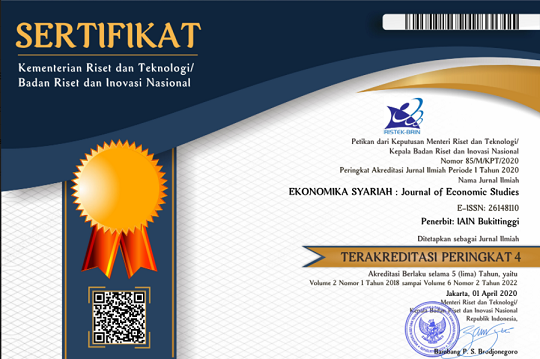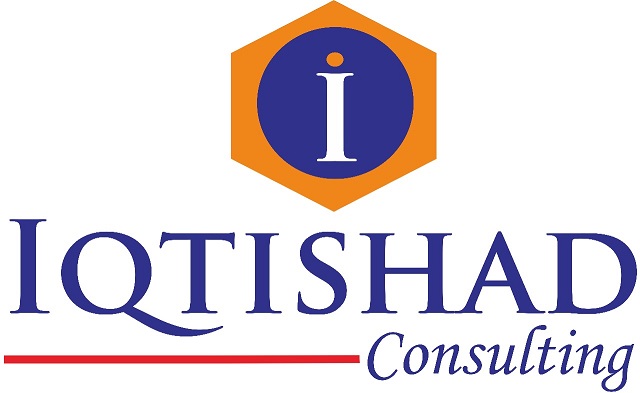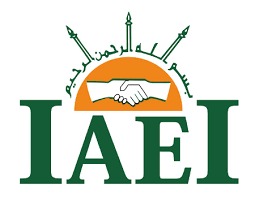Analyzing the Relationship between Economic Indicators, Demographics, and Islamic Bank Assets in High-Asset OIC Countries
Keywords:
Islamic Bank Assets, Oil Prices, Muslim PopulationAbstract
Islamic banking has expanded substantially over the past decade, however the number of institutions does not always correspond to the scale of asset accumulation. This study aims to examine the key macroeconomic and demographic determinants that influence Islamic banking asset growth in the ten countries with the highest Islamic banking assets globally. Using panel data regression with a fixed effect model over the period 2015 to 2023, this study investigates the impact of per capita income, inflation, oil prices, and Muslim population on asset growth. The findings show that, collectively, these variables significantly affect the growth of Islamic banking assets. However, only per capita income (10% significance level) and Muslim population (1% significance level) have significant individual effects, while inflation and oil prices are statistically insignificant. The novelty of this research lies in its extended time frame (2015–2023) and its focus on asset accumulation rather than profitability, an aspect relatively underexplored in previous studies. Furthermore, by concentrating on top-performing Islamic banking countries, the study offers fresh insights into the structural and religious-demographic drivers of Islamic financial development. These findings provide practical implications for policymakers and Islamic financial institutions seeking to foster sustainable growth, particularly in regions with strategic demographic advantages.
Perbankan Islam mengalami pertumbuhan signifikan dalam satu dekade terakhir, namun jumlah institusi yang ada belum mencerminkan skala akumulasi aset yang berhasil dihimpun. Penelitian ini bertujuan untuk mengkaji determinan makroekonomi dan demografis utama yang memengaruhi pertumbuhan aset perbankan Islam di sepuluh negara dengan total aset perbankan Islam tertinggi di dunia. Dengan menggunakan regresi data panel model efek tetap (fixed effect model) selama periode 2015 hingga 2023, studi ini menganalisis pengaruh pendapatan per kapita, inflasi, harga minyak, dan populasi Muslim terhadap pertumbuhan aset. Hasil analisis menunjukkan bahwa secara simultan, variabel-variabel tersebut berpengaruh signifikan terhadap pertumbuhan aset perbankan Islam. Namun secara parsial, hanya pendapatan per kapita (signifikan pada tingkat 10%) dan populasi Muslim (signifikan pada tingkat 1%) yang berpengaruh signifikan, sedangkan inflasi dan harga minyak tidak signifikan secara statistik. Kebaruan penelitian ini terletak pada cakupan waktu yang lebih panjang (2015–2023) dan fokusnya pada dimensi akumulasi aset, bukan profitabilitas, yang masih jarang dikaji dalam studi sebelumnya. Selain itu, fokus pada negara-negara dengan kinerja perbankan Islam tertinggi menghasilkan temuan baru terkait peran faktor struktural ekonomi dan demografis-religius. Temuan ini memberikan implikasi praktis bagi pembuat kebijakan dan lembaga keuangan syariah dalam merancang strategi penguatan sektor perbankan Islam jangka panjang.
References
(IFDI), I. F. D. R. (2024). ICD - LSEG ISLAMIC FINANCE DEVELOPMENT REPORT 2024. In ICD. ICD.
Abdelzaher, M. A. (2022). The Impact of Macroeconomic and Specific Factors of Commercial and Islamic Banks on Profitability Evidence from Egyptian Market. International Journal of Economics and Financial Issues, 12(2), 16–25. https://doi.org/10.32479/ijefi.12776
Abou Elseoud, M. S., Yassin, M., & Ali, M. A. M. (2020). Using a panel data approach to determining the key factors of Islamic banks’ profitability in Bahrain. Cogent Business and Management, 7(1). https://doi.org/10.1080/23311975.2020.1831754
Abu Zahrah, M. (1997). Usul al-Fiqh. Cairo: Dar al-Fikr al-Arabi.
Al-Ajmi, J., Hussain, H. A., & Al-Saleh, N. (2009). Clients of conventional and Islamic banks in Bahrain: How they choose which bank to patronize. International Journal of Social Economics, 36(11), 1086–1112. https://doi.org/10.1108/03068290910992642
Alharbi, A. T. (2017). Determinants of Islamic banks’ profitability: international evidence. International Journal of Islamic and Middle Eastern Finance and Management, 10(3), 331–350. https://doi.org/10.1108/IMEFM-12-2015-0161
Allen, F., & Santomero, A. M. (1997). The theory of financial intermediation. Journal of Banking and Finance, 21(11–12), 1461–1485. https://doi.org/10.1016/S0378-4266(97)00032-0
Amzal, C. (2016). the Impact of Macroeconomic Variables on Indonesia Islamic Banks Profitability Article History. Jurnal Ekonomi Dan Bisnis Islam, 2(1), 71–86.
Bakhouche, A., El Ghak, T., & Alshiab, M. (2022). Does Islamicity matter for the stability of Islamic banks in dual banking systems? Heliyon, 8(4). https://doi.org/10.1016/j.heliyon.2022.e09245
Batorshyna, A., Tokar, V., Kolinets, L., Sybyrka, L., & Almarashdi, O. (2021). THE INTERPLAY BETWEEN THE GLOBAL ISLAMIC FINANCE AND ECONOMIC GROWTH OF MUSLIM COUNTRIES. Financial and Credit Activity Problems of Theory and Practice, 3(38), 231–239. https://doi.org/10.18371/fcaptp.v3i38.237452
Budiman, T., Satyakti, Y., & Febrian, E. (2021). Islamic bank sustainability: An econometric approach. In Asian Economic and Financial Review (Vol. 11, Issue 2, pp. 141–159). https://doi.org/10.18488/JOURNAL.AEFR.2021.112.141.159
Chapra, M. U. (1998). The Future of Economics: An Islamic Perspective. Journal of Islamic Studies, 9(1), 110–112.
Chowdhury, E. K., Dhar, B. K., Thanakijsombat, T., & Stasi, A. (2022). Strategies to determine the determinants of financial performance of conventional and Islamic commercial banks: Evidence from Bangladesh. Business Strategy and Development, 5(4), 405–423. https://doi.org/10.1002/bsd2.207
Dusuki, A. W., & Bouheraoua, S. (2011). The Framework of Maqasid al-Shari’ah and its Implication for Islamic Finance. ICR Journal, 2(2), 316–336. https://doi.org/10.52282/icr.v2i2.651
Effendi, K. A. (2019). Oil prices and macroeconomic on the islamic banking performance in OPEC member countries. International Journal of Energy Economics and Policy, 9(1), 200–204. https://doi.org/10.32479/ijeep.7098
Gujarati, D. N., & Porter, D. C. (2010). Dasar-Dasar Ekonometrika. In Revista de Administração de Empresas (Vol. 16, Issue 3).
Hanifah, Z. E. D., & Zuhroh, I. (2024). ANALISIS PROFITABILITAS PERBANKAN SYARIAH DI NEGARA OKI. Journal of Financial Economics & Investment, 4(2), 93–104. https://doi.org/10.22219/jofei.v4i2.32848
Hidayat, I., Alwahidin, A., & Aspiani, T. (2020). The Effect of Inflation, Interest Rate, and Gross Domestic Product on the Profitability of Sharia Banking in Indonesia (Sharia Banking Financial Reports 2014-2018). Journal Industrial Engineering & Management Research ( Jiemar), 1(4), 2722–8878.
Imam, P. A., & Kpodar, K. (2010). Islamic Banking: How Has it Diffused? IMF Working Papers, 10(195), i. https://doi.org/10.5089/9781455205257.001
Imam, P., & Kpodar, K. (2015). Is Islamic Banking Good for Growth? IMF Working Papers, 15(81), 1. https://doi.org/10.5089/9781475569285.001
Indrawati, A., Putri, F. H., & Wahyudi, R. (2022). Analisis Kinerja Bank Syariah Negara OKI pada Era Digital: Studi Masa Pandemi Covid-19. Journal Of Institution And Sharia Finance, 5(1), 51–65. https://doi.org/10.24256/joins.v5i2.3360
Jadah, H. M., Alghanimi, M. H. A., Al-Dahaan, N. S. H., & Al-Husainy, N. H. M. (2020). Internal and external determinants of Iraqi bank profitability. Banks and Bank Systems, 15(2), 79–93. https://doi.org/10.21511/bbs.15(2).2020.08
JAVED, Z. H., HASAN, M. U., & AROOG, I. (2021). Impact of Macroeconomic Variables on Growth of Assets in Islamic Banks: A Case of Pakistan. International Review of Management and Business Research, 10(1), 33–37. https://doi.org/10.30543/10-1(2021)-4
Kahn, R. F. (2022). ‘The General Theory of Employment, Interest and Money.’ In Palgrave Studies in the History of Economic Thought (pp. 119–160). London: Macmillan. https://doi.org/10.1007/978-3-030-98588-2_7
Kamali, M. H. (2008). Maqasid al-Shariah Made Simple. International Institute of Advanced Islamic Studies (IAIS) Malaysia.
Khan, M. F., Ali, M. S., Hossain, M. N., & Bairagi, M. (2023). Determinants of non-performing loans in conventional and Islamic banks: Emerging market evidence. Modern Finance, 1(1), 56–69. https://doi.org/10.61351/mf.v1i1.27
Kholis, N. (2018). POTRET PERKEMBANGAN DAN PRAKTIK KEUANGAN ISLAM DI DUNIA. Millah: Journal of Religious Studies, 1–30. https://doi.org/10.20885/millah.vol17.iss1.art1
KNEKS. (2025). Perkembangan Total Aset Keuangan Syariah: Momentum Awal Tahun 2025. Kneks.Go.Id.
Kristianingsih. (2022). No Title. Jurnal Ekuitas, 3(4).
Lalon, R. M., Anika Afroz, & Tasneema Khan. (2023). Impact of Bank Liquidity and Macroeconomic Determinants on Profitability of Commercial Banks in Bangladesh. International Journal of Economics and Financial Issues, 13(6), 177–186. https://doi.org/10.32479/ijefi.15228
Levine, R. (2005). Chapter 12 Finance and Growth: Theory and Evidence. In Handbook of Economic Growth (Vol. 1, Issue SUPPL. PART A, pp. 865–934). https://doi.org/10.1016/S1574-0684(05)01012-9
Mankiw, N. G. (2020). Macroeconomics (10th ed.). New York: Worth Publishers.
Massadeh, D. D., Khatib, A. Y. Al, & Khanji, I. M. (2021). ANALYZING THE PROFITABILITY INDICATORS FOR ISLAMIC BANKS IN JORDAN. International Journal of Economics and Finance Studies, 13(1), 67–89. https://doi.org/10.34109/ijefs.202112225
Nahar, S., & Sarker, N. (2016). Are Macroeconomic Factors Substantially Influential For Islamic Bank Financing? Cross-Country Evidence. IOSR Journal of Business and Management, 18(6), 2319–7668. https://doi.org/10.9790/487X-1806012027
Naser, H., Sultanova, G., & Nahar, S. (2024). The Impact of Fintech Innovation on Bank’s Performance: Evidence from the Kingdom of Bahrain. International Journal of Economics and Financial Issues, 14(1), 136–143. https://doi.org/10.32479/ijefi.15512
Nasfi, N., Resti, O., Asnah, A., Febrianti, E., & Suhatman, S. (2023). Pengetahuan, Fitur Produk Dan Kebutuhan Produk Terhadap Keinginan Mengunakan Jasa Layanan Bank Syariah di Pondok Pesantren. Al-Bank: Journal of Islamic Banking and Finance, 3(1), 1. https://doi.org/10.31958/ab.v3i1.8296
Nugroho, L., Mastur, A. A., Harnovinsah, & Aryanti, W. (2020). The Contribution of Islamic Bank in Poverty Alleviation. Al-Ahkam, 30(1), 19–38. https://doi.org/10.21580/ahkam.2020.30.1.5387
Purwasih, H., & Wibowo, W. (2021). the Determinants Factors of Profitability Islamic Bank in Indonesia. Jurnal Muara Ilmu Ekonomi Dan Bisnis, 5(1), 89. https://doi.org/10.24912/jmieb.v5i1.10023
Rahmalia, N. R., Ruhadi, R., & Mayasari, I. (2022). Pengaruh Inflasi terhadap Pertumbuhan Aset dengan Struktur Modal sebagai Variabel Intervening. Journal of Applied Islamic Economics and Finance, 2(2), 370–378. https://doi.org/10.35313/jaief.v2i2.3003
Review, W. P. (2025). Muslim Population by Country 2025.
Rizal, F., & Humaidi, M. (2019). Dampak Makroekonomi terhadap Profitabilitas Perbankan Syariah di Indonesia. El-Barka: Journal of Islamic Economics and Business, 2(2), 300. https://doi.org/10.21154/elbarka.v2i2.1800
Sari, A. C., & Adinugraha, H. H. (2022). Implementation of QRIS-Based Payments Towards the Digitalization of Indonesian MSMEs. EKONOMIKA SYARIAH: Journal of Economic Studies, 5(2), 124–139.
SESRIC. (2023). OIC Economic Outlook 2023: Structural Transformation and Private Sector Development in OIC Member Countries.
Shah, S. F., Albaity, M., & Rahman, M. (2023). Banks’ return reaction to freedom, sentiment, and uncertainty. Journal of Open Innovation: Technology, Market, and Complexity, 9(1). https://doi.org/10.1016/j.joitmc.2023.100015
Sitompul, S., Nurul Ichsan, R., & Nasution, L. (2021). Journal of Economics, Finance and Management Studies The Influence of Exchange Rate, Inflation, For the Results of the Development Assets of Islamic Banks. Journal of Economics, Finance and Management Studies, Volume 4(Issue 03 March 2021), 138–148.
Slimane, S. Ben, & Alsolamy, M. Q. (2024). Impact of Oil Price Shocks on Islamic and Conventional Bank Performance: Empirical Evidence from Saudi Arabia. International Journal of Energy Economics and Policy, 14(5), 629–642. https://doi.org/10.32479/ijeep.16693
Syarif, R. (2024). Studi Bank Syariah di Wilayah GCC. Universitas Islam Negeri Malang.
Tasnova, N. (2022). Impact of Bank Specific and Macroeconomic Determinants on Banks Liquidity. Finance & Economics Review, 4(1), 11–24. https://doi.org/10.38157/fer.v4i1.372
Tiara Putri, A., Yuliana, S., & Yulianita, A. (2019). Dana pihak ketiga, Inflasi dan Pembiayaan Mudharabah terhadap Non Performing Financing pada Bank Islam di Indonesia dan Malaysia. Jurnal Ekonomi Pembangunan, 16(2), 74–80. https://doi.org/10.29259/jep.v16i2.8883
Downloads
Published
How to Cite
Issue
Section
Citation Check
License
Copyright (c) 2025 Fitri Utami

This work is licensed under a Creative Commons Attribution-ShareAlike 4.0 International License.
Authors who publish with this journal agree to the following terms:
- Authors retain copyright and grant the journal right of first publication with the work simultaneously licensed under a Creative Commons Attribution-ShareAlike 4.0 International License that allows others to share the work with an acknowledgment of the work's authorship and initial publication in this journal.
- Authors are able to enter into separate, additional contractual arrangements for the non-exclusive distribution of the journal's published version of the work (e.g., post it to an institutional repository or publish it in a book), with an acknowledgment of its initial publication in this journal.
- Authors are permitted and encouraged to post their work online (e.g., in institutional repositories or on their website) prior to and during the submission process, as it can lead to productive exchanges, as well as earlier and greater citation of published work (See The Effect of Open Access).




